Last Updated on January 28, 2023 by Nathaniel Tower
If you want to be a great storyteller, you have to know how to write dialogue.
I’m about to make a shocking confession: sometimes when I’m reading a book, I’ll start skimming. And when I skim, I often will pass quickly through large blocks of narrative in search of dialogue. Thankfully, the dialogue will usually get me back on track.
As a reader, I love reading dialogue. As a writer, I tend to overuse it at times, particularly during a first draft. Nonetheless, I love writing dialogue because it’s where the characters can really shine and help the story become more powerful.
Don’t get me wrong. Narration can be just as powerful. But dialogue is often far more memorable and makes your story more relatable for your readers. And that’s why it’s essential for writers to understand how to write great dialogue.
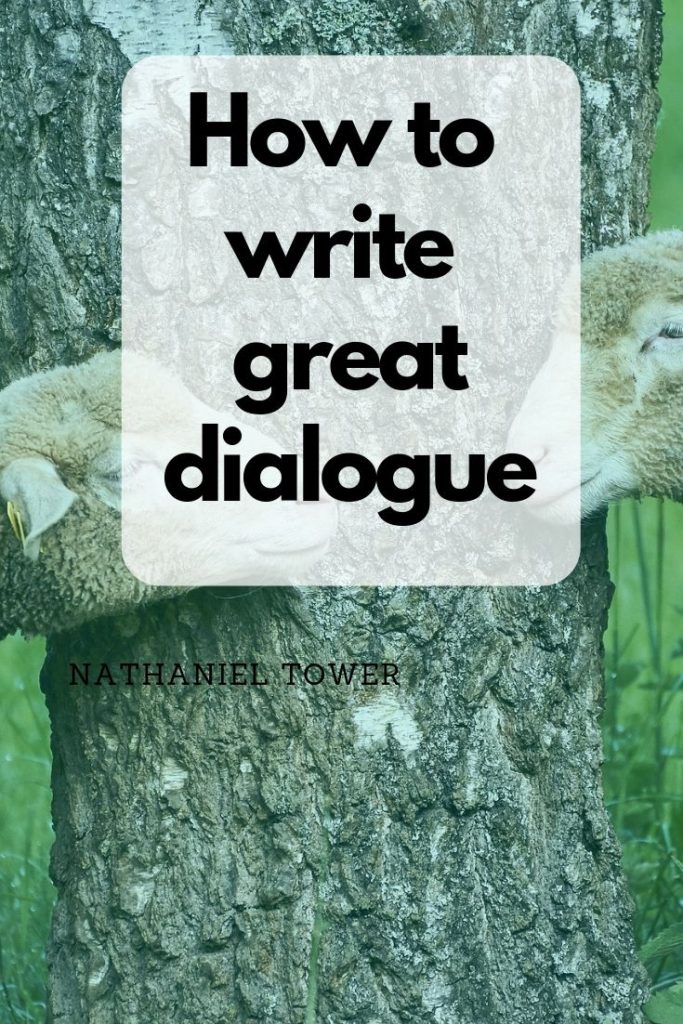
The two sides of writing dialogue
There are two primary aspects to writing effective and compelling dialogue:
- The technical side – This is the boring but essential stuff like proper conventions, punctuation, etc.
- The execution – This is the fun stuff. Here I’m talking about the actual words the characters say. In order to effectively execute, you need to make it real, engaging, compelling, impactful, etc.
The second is much harder to do, but if you don’t get the first point down first, it won’t matter how brilliant the dialogue is.
So let’s get the technical side out of the way. Here’s what you need to know:
Dialogue goes in quotation marks
Feel free to fight me on this one. I know it’s experimental and hip to leave out the quotation marks. But let me tell you this: 9 out of 10 times, this creates a lousy and confusing experience for the reader. There’s a really good reason why we put dialogue in quotation marks: it makes it clear someone is talking.
I’ve yet to hear a good reason why quotation marks should be omitted. If you want to write your story without them, make sure you have a damn good reason beyond, “Hey, I just want to do something different.”
Punctuating dialogue is easy (and proper capitalization isn’t hard either)
It really shouldn’t be that hard, but I see writers screw this up all the time. Of course, the ones who can’t punctuate dialogue properly also tend to write terrible dialogue, but maybe that’s just because they are so confused about the conventions.
Okay, we’re going to have to break this one into some sub-rules, and I’m going to have to use a lot of examples.
Punctuation goes inside the closing quotation mark. This includes commas, periods, exclamation points, and question marks. Yes, there are times when certain punctuation can go outside of a quotation mark, but when you are talking about dialogue, put it inside. Here are some examples:
- Sally said, “I’m really excited!”
- Sally said, “You should always put punctuation inside the quotation marks.”
- Sally asked, “Are you seriously going to omit quotation marks in your dialogue?”
- “Let’s write some dialogue,” said Sally.
- “Do you like the dialogue I have written?” asked Sally.
Capitalize the beginning of a quotation. Whenever you are starting a quotation, the first letter is always capitalized regardless of whether or not it’s the start of the sentence. Note the second example below. If the dialogue is interrupted with narration and then continued within the same sentence, you should not capitalize the second string of dialogue. Examples:
- Sally gazed upon the glistening dew and said, “Properly punctuated dialogue is a beautiful thing.”
- “Don’t you think,” Sally began, “that writing dialogue can be a beautiful thing?”
Don’t capitalize the first word outside of the quotation unless it’s a proper noun or a new sentence. This is true regardless of the punctuation mark in the quotation. I’ve already shown a couple examples of this above, but let’s look again:
- “I love writing dialogue!” she shouted at the top of her lungs.
- “Don’t you love the way dialogue looks on paper?” she asked.
- “This is a beautiful sentence,” said Sally.
That wasn’t too hard, right? If you can remember those three basic rules, then you’ll be in great shape and both your readers and your characters will thank you.
Start a new paragraph when a new speaker is talking
Remember the first rule about using quotation marks? We did that to make it easier on our readers. And that’s why we’re going to start a new paragraph when a new speaker is talking. Once again, it can be cool and experimental to have a really long paragraph with a bunch of speakers confined within, but it pretty much always sucks.
Look, I’m not a prude when it comes to experimentation in writing. There’s just certain things that aren’t worth experimenting with. Omitting quotation marks or jamming multiple speakers into a single paragraph doesn’t make your story more meaningful. It just makes it harder to read.
Here’s an example of this in action:
“I’m not sure how to write dialogue,” Johnny said to Sally.
Sally looked Johnny in the eyes and smiled. “It’s really not that hard,” she said as she touched his cheek.
“That’s easy for you to say. You’ve been doing it for years. You have three published books. I’m a nobody.”
“We all start as nobodies.”
Johnny laughed. “You can say that again.”
See how easy it is to tell who is speaking? And see how much more meaning comes out of every bit of dialogue when it’s given the proper room to breathe. Even this relatively meaningless exchange is vastly improved by the pacing created through paragraphing.
So those are the basics from the technical side. Not too hard, right?
Now we have to get into the other, much more complex side of how to write great dialogue. Let’s start simple:
Don’t use a thesaurus to find synonyms for “said”
People say things. They don’t emote, whinny, sigh, or express them. It’s okay to use “said” most of the time. It’s not acceptable to find a different synonym every time someone talks.
At some point, someone started teaching people they shouldn’t use “said” as part of a dialogue tag. Whoever started that trend was wrong. I’d love to blame it on the anti-quotation mark movement, but it’s a separate epidemic led by a different group of people.
When you use different verbs in your dialogue tags, you are taking away the significance of the dialogue and putting it onto the tag instead. Put another way, the words of your characters lose impact and you as the writer become an intrusive narrator who doesn’t trust your characters.
It’s also okay to forego the dialogue tags completely in favor of actions outside of speech.
Example: Sally grabbed her pen. “I love writing dialogue.”
It’s obvious that Sally is speaking even though we didn’t explicitly say she said it. We can also imagine how she’s saying it based on what she is saying as well as the context around it. We don’t need to be told whether she shouted, exclaimed, or whispered it. The fact that she grabbed her pen and said she loves writing dialogue tells us all we need to know.
And don’t even think about using an adverb to tell the read how it was said. If Sally said it boldly, then you better make that clear by her actions and the other characters’ reactions.
Make dialogue real (but not too real)
Dialogue is a great opportunity to make your characters relatable and real. To do so, they need to sound like real people. Here are some helpful tips to accomplish that:
- People speak in contractions and use slang/informal language when they talk. Your dialogue should reflect this. Don’t make your dialogue sound like an academic essay.
- People don’t say each other’s names very often when they are addressing each other. Don’t make your characters frequently spit out the other person’s name.
- People don’t usually speak in huge blocks of text when they are having a conversation. Make your dialogue short and to the point.
- People don’t describe their actions as they are doing them. That’s what narration is for.
- People do occasionally use filler words, such as “like,” “umm,” and a few others. Sprinkle these in as appropriate, but don’t overdo them. Think of how insufferable it is to listen to someone who says “like” a lot. Reading it a lot is even worse.
At the same time, you shouldn’t try too hard to emulate speech patterns. This is particularly true when it comes to writing dialects. Unless you are an exceptional writer with a masterful comprehension of a specific dialect, you’re going to butcher it when you try to write it.
Your dialogue doesn’t need to be a perfect representation of speech patterns, accents, and dialects. Just make it seem real and make it easy for your readers to comprehend.
Make dialogue meaningful, but don’t force it
No one wants to read filler. Every word in your story or novel should be important, especially the dialogue.
When I say that, I mean it should be important for the flow and meaning of the story. That certainly doesn’t mean every word and every line of dialogue has to be brilliant and memorable. People say plenty of non-brilliant things. Let your characters be themselves. Don’t stuff your dialogue so full of memorable one-liners that it comes across as inauthentic.
Meaningful dialogue will do the following:
- Reveal important things about your characters’ personalities and actions
- Help the plot move forward in a natural way
- Make your characters feel like real people
- Hint at subtleties that are deeper than what the characters are actually speaking about in the moment
Although we can think of many famous quotes from literature and movies that are dialogue, remember there are infinitely more character quotes that mean absolutely nothing out of context. Your job as a writer isn’t to make every single line profound. It’s to tell a meaningful, engaging story that will resonate with your audience.
Bad dialogue examples – What to avoid when writing dialogue
Here are four visual and text examples of bad dialogue. Whatever you do, don’t write dialogue like this:
Don’t use dialogue to describe everything

“Look at that,” he stated.
“What?” he asked.
“The thing I am pointing at,” he replied.
“What are you pointing at?” he asked.
“The glowing orange sunset piercing through those marshmallow clouds in the sky blue sky,” he said while pointing.
“Oh. Why didn’t you say that in the first place rather than just pointing at the sky,” he said.
If you are trying to describe things, use narration. People don’t do this in real life.
Don’t use dialogue to convey actions
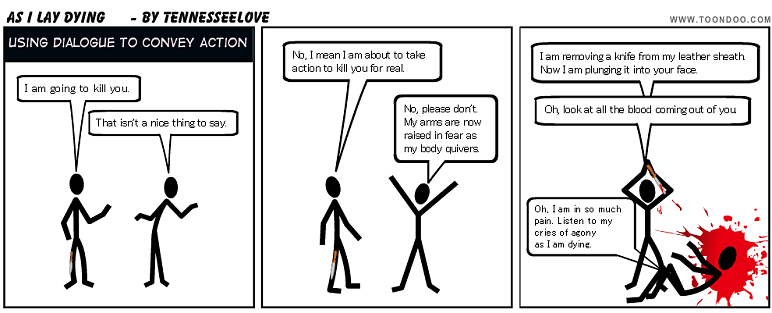
“I am going to kill you,” he said to the other guy.
“That isn’t a nice thing to say,” the other guy said back.
“No, I mean I am about to take action to kill you for real,” the first guy said.
“No, please don’t. My arms are now raised in fear as my body quivers,” the guy who was being threatened said.
“I am removing a knife from my leather sheath. Now I am plunging it into your face. Oh, look at all the blood coming out of you,” the killing guy said.
“Oh, I am in so much pain. Listing to my cries of agony as I am dying,” the dying guy said.
Once again, actions should be conveyed in the narration, not the dialogue. No one describes exactly what they are doing as they do it.
Don’t use dialogue that’s too formal or rigid

“Is it not a beautiful day?” the guy on the stump said.
“Why yes, I am sharing your feelings at this moment,” the other guy said.
“I did not know you were capable of sharing,” the guy who was no longer on the stump said.
“There is much about me which you do not know,” the second guy said.
“Shall we discuss it over a delicious meal?” the first guy said.
“Unfortunately, I do not have the time to make such arrangements. Let us just agree to agree,” the non-stump guy said.
These don’t sound like humans. Make your characters talk like real people.
Don’t use dialogue that tries too hard to sound real
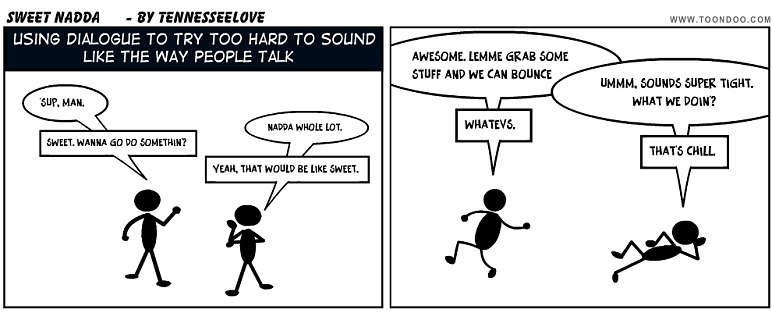
“‘Sup, man,” the one guy said.
“Nadda whole lot,” guy #2 stated.
“Sweet. Wanna go do somethin’,” first guy said.
“Yeah, that would be like sweet,” said #2.
“Awesome. Lemme grab some stuff and we can bounce,” said #1.
“Ummm, sounds super tight. What we doin’?” replied #2.
“Whatevers,” said #1 non-chalantly.
“That’s chill,” said the other insufferable moron.
These also don’t sound like humans. They sound like insufferable morons. I hope your characters aren’t like this.
Also, make sure your dialogue doesn’t overuse profanity, which can be a turnoff for many readers.
Of course, these are extreme examples of bad dialogue, but they should give you the idea of how bad dialogue can derail your writing.
A special thank you to my good friend and exceptional writer April Bradley for creating the images above.
Further reading on how to write dialogue
It’s impossible to teach someone how to be an expert at writing dialogue in a single blog post. In order to really master this skill, you need to read and practice. Here are some sources for you:
- The Bartleby Snopes Dialogue Contest – This was a short story contest I hosted for 9 years. The basic premise was that stories could only consist of dialogue. Check out the winners to see how dialogue can effectively drive plot and character.
- Hemingway’s “Hills Like White Elephants” – If you haven’t read this story before, then read it before you ever write another line of dialogue. The way Hemingway moves the story forward and subtly reveals everything about the characters through short, authentic dialogue is essentially a master class on writing dialogue.
There are plenty of other resources out there for writing great dialogue, but I don’t want to overwhelm you. Besides, it’s time for you to go try it yourself.
How to Write Dialogue FAQ
What is dialogue?
When we refer to dialogue in writing, we are referring to the speech of characters. Whether it’s one person talking to him/herself, two people talking back and forth, or a whole group of people chatting, you have dialogue.
How do you write dialogue?
Writing dialogue requires both technical formatting and natural execution. When writing dialogue, make sure you use quotation marks and also make it clear who is speaking. Dialogue should be written in a natural way that feels realistic without being forced. Don’t try too hard to write like people talk, but make sure you the speech isn’t too formal either.
Should dialogue go in quotation marks?
Generally speaking, dialogue should always go in quotation marks. Some experimental writing does not use quotation marks, but this can make it difficult for your reader to follow along. If you are going to write dialogue without quotation marks, make sure you have a good reason for doing so.
Where does punctuation go in dialogue?
When writing dialogue, punctuation should always go inside the quotation marks.
Should you capitalize the beginning of a quotation?
Yes, you should always capitalize the first letter of a quotation, even when the quotation starts in the middle of the sentence.
Should you start a new paragraph for dialogue?
You don’t need to start a new paragraph unless there is a change in speaker. Every time you have a new speaker, you should start a new paragraph to make it clear that someone new is speaking. However, you don't need to start a new paragraph if the speaker's dialogue fits within the context of the current paragraph.
What is a dialogue tag?
A dialogue tag is a form of narration in which you indicate who is speaking. You don’t always need a dialogue tag, but it can be helpful to make speech clear. A dialogue tag can come before or after the quote.
Is it okay to use said in dialogue tags?
It’s perfectly acceptable to use said in your dialogue tags. In fact, many writers and readers prefer said to synonyms for said. It’s also generally frowned upon to use adverbs in dialogue tags. You should be able to convey how someone is saying something through the dialogue itself.
As always, please share your thoughts, comments, and questions about writing dialogue in the comments. And don’t forget to share this post on all your favorite channels.
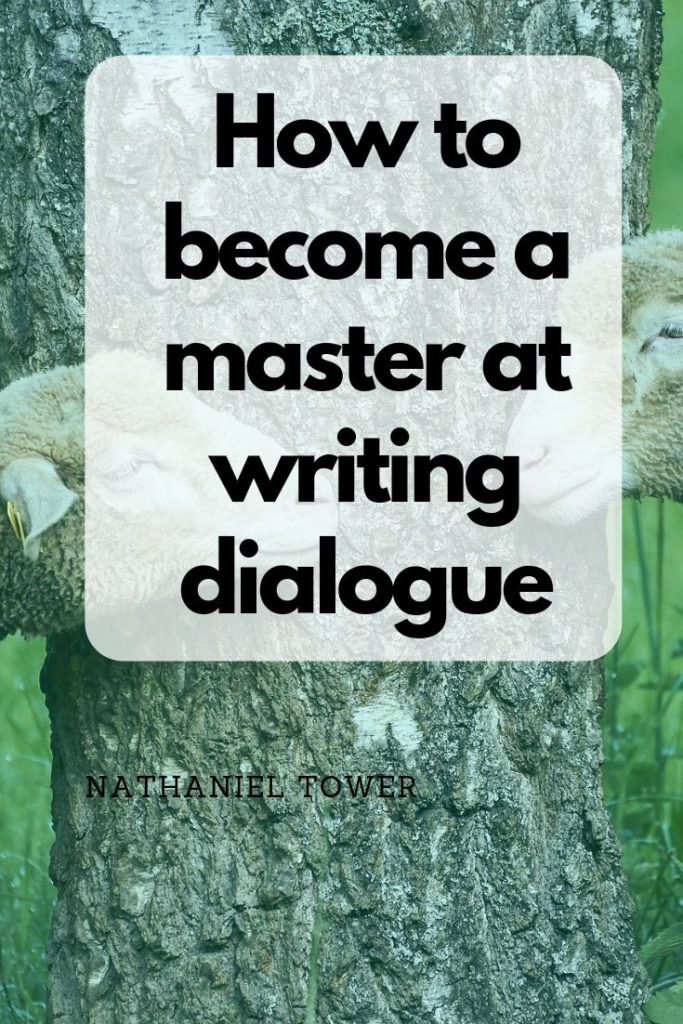

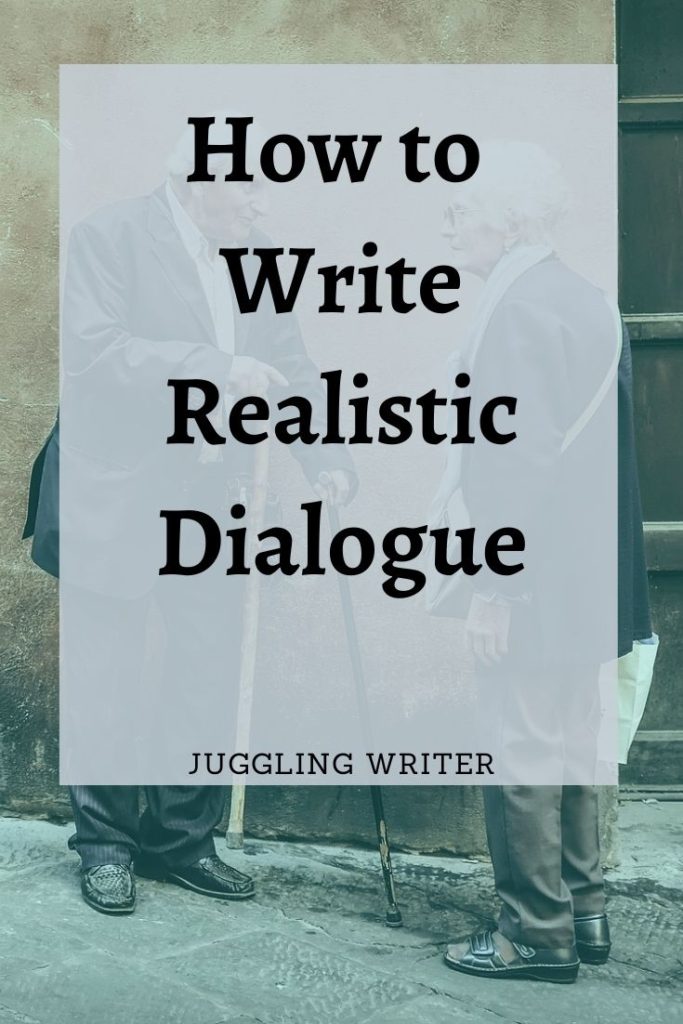
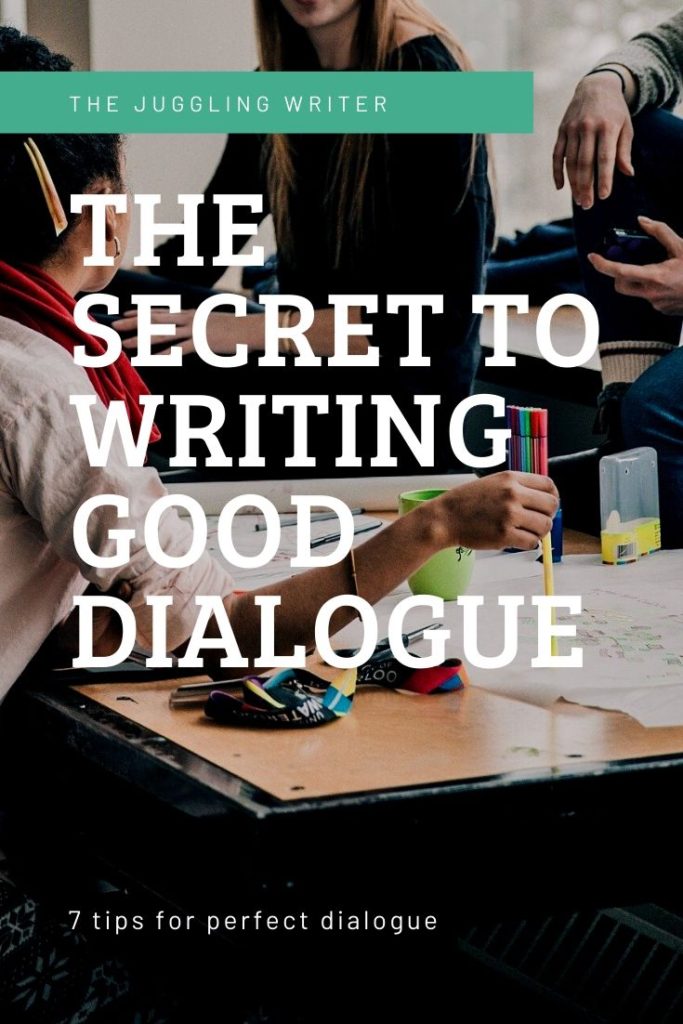
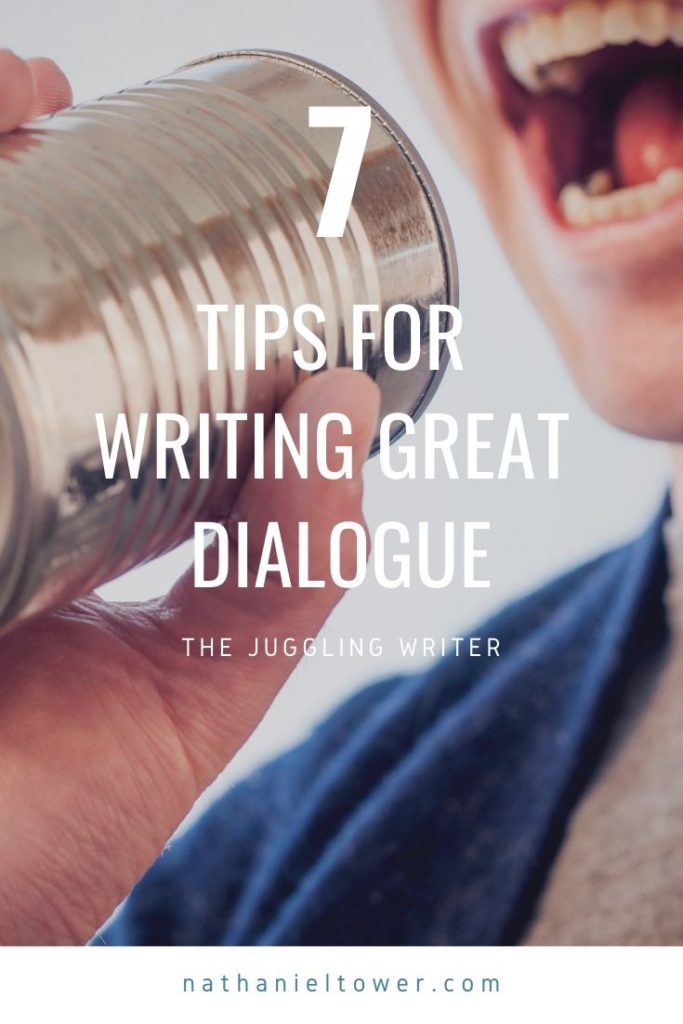
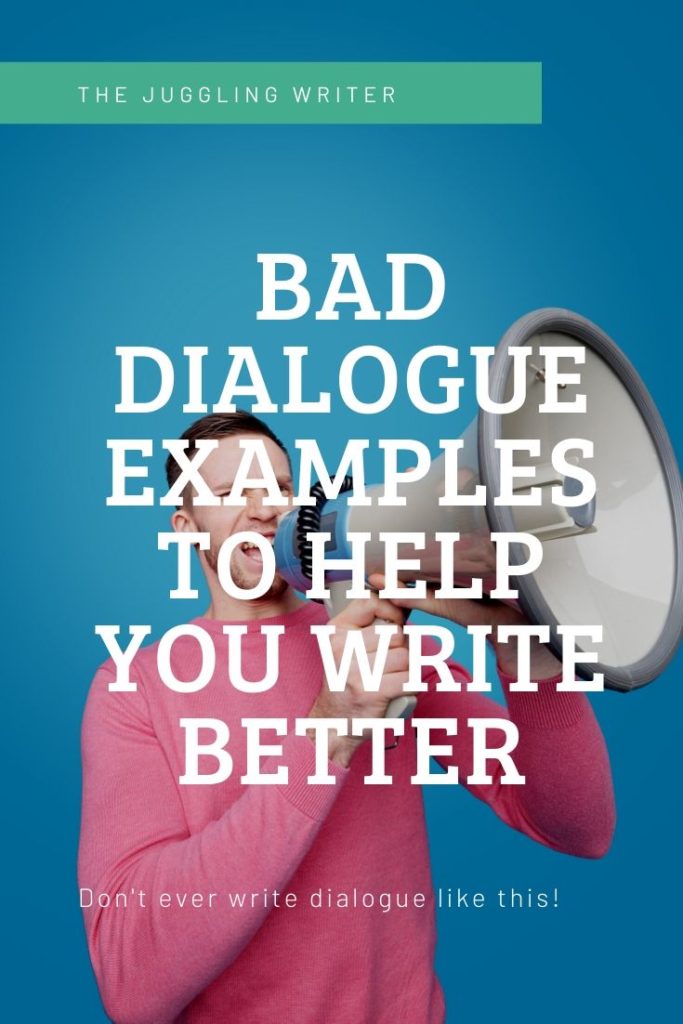

Excellent tips! I’m agree with you about no quote marks. I once read a book that didn’t have them and it was so frustrating. Turned me off wanting to read anything else by that author.
While I agree with using contractions and some slang, it’s possible for writers to overdo it. I’ve seen attempts to portray us “country folk” as Okies from the Great Depression. Shockingly enough, a lot of us speak with decent grammar. It’s important to spend time with people in order to avoid crassly stereotyping the characters.
Very useful tips thanks! But it makes me wonder on the one of the ‘DON’T’s – which says, don’t make it too formal/rigid. Don’t you think it also depends on the character? I know it’s not often but it can happen. I’ve read books or seen movies in which the character is, for example, a stiff, super formal lady with a royal British background. She really spoke so cold, distant and ‘official’ like you’re reading academic report.
This is a great point. Ultimately, the dialogue should fit the character – and it should tell us more about the character. As with any writing rules, there are always exceptions!
Q: when writing a word or words within dialogue, like your use of the word said above, shouldn’t you use single quotes around the word?